A sleep researcher who spent 33 days in a cave. The persecution of female healers as witches. Parents racing to find a cure before their children succumb to a rare disease. These are among the tales told in this year’s list of recently published books by, for, and about doctors.
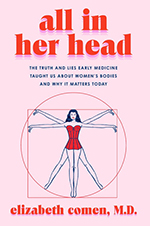
All in Her Head: The Truth and Lies Early Medicine Taught Us About Women’s Bodies and Why It Matters Today by Elizabeth Comen, MD
Women are diagnosed with cancer and heart disease later than men, aren't offered pain medication as frequently, and far too often find their symptoms dismissed as “all in their heads.” Medical historian and oncologist Elizabeth Comen, MD, traces the cause of these inequities back centuries to the foundational mistruth that women’s bodies — and mental abilities — are inherently inferior to men’s. Among the medical injustices Comen describes are the persecution of female healers as witches and the lobotomizing of women who dared to defy their husbands. Women of color, she notes, were subjected to even greater victimization. Weaving together patient stories, expert interviews, and her own experiences of sexism in medicine, Comen offers women readers wisdom for healing internalized shame about their bodies and advocating for the quality care that they deserve.
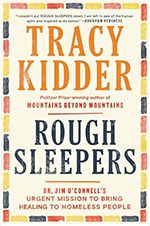
Rough Sleepers: Dr. Jim O’Connell’s Urgent Mission to Bring Healing to Homeless People by Tracy Kidder
For decades, Jim O’Connell, MD, has helped care for thousands of Boston’s “rough sleepers” — homeless people who spend their nights on dirty, dangerous streets. Pulitzer Prize-winning writer Tracy Kidder followed O’Connell over the course of five years, watching the director of the Boston Health Care for the Homeless Program dispense medicine, food, and basic supplies — as well as vast amounts of empathy. Along the way, Kidder chronicles O’Connell’s complex relationship with “Tony,” a man who suffered from drug addiction and a painful past and was fiercely protective of his peers. Although the work sometimes takes a huge toll on O’Connell, he believes he must forge ahead anyway. He says simply, “This is what we do while we’re waiting for the world to change.”
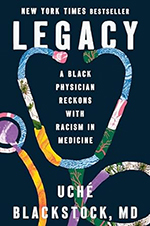
Legacy: A Black Physician Reckons with Racism in Medicine by Uché Blackstock, MD
As a child, Uché Blackstock, MD, couldn’t wait to follow in her physician mother’s footsteps. But after graduating from Harvard Medical School, she trained as a resident at Kings County Hospital in Brooklyn, the same under-resourced hospital where her mother worked, and was pained by how deeply the American legacy of racist practices and policies undermined Black people’s health. Later, while working as an emergency medicine physician at New York University, Blackstock saw the inequities even more starkly. Ultimately, Blackstock left academic medicine and started a consultancy to guide hospitals and health systems working to increase equity in medicine. Legacy, which is simultaneously a scathing social critique and a deeply personal memoir, suggests a way forward — preparing young Black children for careers in medicine, for example — toward greater health equity for all Americans.
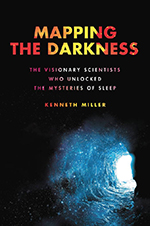
Mapping the Darkness: The Visionary Scientists Who Unlocked the Mysteries of Sleep by Kenneth Miller
In 1938, Nathaniel Kleitman, PhD, spent 33 days deep inside a Kentucky cave, avoiding the earth’s cycles of day and night. He hoped to plumb the mysteries of sleep — its strange rhythms, biological purposes, and possible disruptions. Award-winning journalist Kenneth Miller profiles Kleitman along with three other research pioneers who transformed sleep study from a fringe occupation to a serious science. Among their discoveries were the dream state called REM — University of Chicago researcher Eugene Aserinsky, PhD, serendipitously noticed the fluttering of his sleep subjects’ eyelids — as well as treatments for such conditions as narcolepsy. Then in the 1970s, a Stanford University graduate student, Mary Carskadon, PhD, revealed a dangerous epidemic of sleep deprivation among U.S. teens and began working to address it. Although such dedicated researchers have taught us much — we no longer see sleep as simple nothingness or a bad habit to overcome — Miller cautions that society still treats the need for slumber with far too little respect.
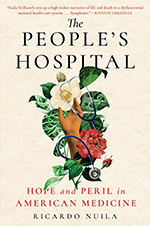
The People’s Hospital: Hope and Peril in American Medicine by Ricardo Nuila, MD
Ebonie is a young mom whose pregnancy threatens her life. Geronimo is a young man with liver failure whose meager disability check disqualifies him for Medicaid. And Roxana is an uninsured Salvadoran immigrant whose difficulty receiving care leaves her with limbs requiring amputation. These are some of the patients whom hospitalist Ricardo Nuila, MD, treats at Houston’s Ben Taub Hospital, where care is delivered regardless of ability to pay. In this deeply heartfelt book, Nuila interweaves patient stories with a scathing condemnation of the medical systems, insurance models, and public policies that necessitate such safety-net institutions. To provide better care to more people, institutions need to meld compassion with cost-conscious steps like assessing whether a patient really needs a particular test, Nuila argues. He believes his hospital proves such a model is possible. Ben Taub provides excellent care — it boasts an outstanding response time to the deadliest kinds of heart attack, for example — while spending less than half the national average on its patients, he writes.
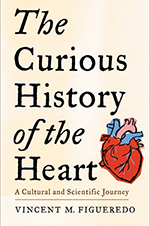
The Curious History of the Heart: A Cultural and Scientific Journey by Vincent M. Figueredo, MD
For centuries, people considered the heart the repository of intelligence, memory, emotion — and even the soul. Ancient Aztecs sacrificed a human heart to the gods, and Egyptian mummification rituals honored the organ, explains cardiologist Vincent Figueredo, MD. But after the heart was revealed as a mechanical pump in the 17th century, the brain — previously deemed “cold gray pudding” — emerged as the home of human consciousness. Even so, the heart remains central to the human experience, appearing in everything from pop music to religious musings to Instagram “like” buttons. In this sweeping book, Figueredo deftly describes the workings of the heart, the scientific advances that have protected it, and such future treatments as cross-species transplantation. Mostly, though, he is fascinated by the interplay between the heart and the brain — he describes the recipient of a heart transplant suddenly craving foods once savored by its donor, for example — and how the emerging field of neurocardiology may reaffirm the heart’s central role in our emotional well-being.
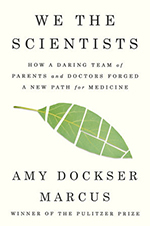
We the Scientists: How a Daring Team of Parents and Doctors Forged a New Path for Medicine by Amy Dockser Marcus
Children with the rare genetic disorder Niemann-Pick disease type C (NPC) usually die before reaching age 20, after slowly losing such basic abilities as walking, talking, and eating. In We the Scientists, Pulitzer Prize-winning author Amy Dockser Marcus — drawn to the topic by her mother’s own rare disease — describes the intense collaboration between parents of children with NPC and scientists determined to save the children’s lives. The effort began in 2007, when a researcher at the National Institutes of Health (NIH) provided access to a cutting-edge, robot-controlled system capable of rapidly screening vast numbers of pharmaceutical compounds to identify those with the greatest treatment potential. In their race for a cure, NPC parents became citizen scientists, helping devise experiments, recording extensive data about their children, and sometimes working directly with the Food and Drug Administration. Although the effort has not yet yielded a cure, the groundwork laid continues to offer hope — the name aptly given to the innovative NIH robot.
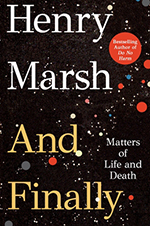
And Finally: Matters of Life and Death by Henry Marsh, MD
When acclaimed British neurosurgeon Henry Marsh, MD, was diagnosed with advanced prostate cancer at 71, he was shocked. Like many other doctors, the author of the best-selling Admissions believed himself somewhat invincible. In the transition to patienthood, Marsh suffered from a sense that he had failed to empathize sufficiently with his patients — yet he also recognized the dangers of excessive physician empathy. While weaving together scientific information and philosophical insights, Marsh shares such indignities as the breast growth and muscle loss that accompanied his treatment. Staring down his own decline, he opines that “long life is not necessarily a good thing. Perhaps we should not seek it too desperately.” Still, he savors his many simple joys, from stargazing to sharing fairytales with his grandchildren. Although in remission at the time of his writing, Marsh recognizes and accepts his own mortality. “I have had my time in the sun, now it is the turn of the next generation,” he writes.
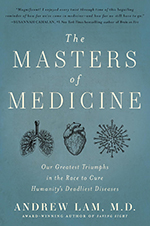
The Masters of Medicine: Our Greatest Triumphs in the Race to Cure Humanity’s Deadliest Diseases by Andrew Lam, MD
An intern who performed a cardiac experiment on his own body against an attending physician's orders. A doctor reviled for his suggestion that sanitizing childbirth instruments would save lives. And surgeons who killed several patients in their quest to achieve human heart transplantation. These aren’t characters pulled from a Hollywood thriller, but rather some of the audacious physicians who risked their careers — and occasionally their lives — to advance medical knowledge and mitigate human suffering. University of Massachusetts ophthalmologist and historian Andrew Lam, MD, captures “the perseverance, skill, and sometimes dumb luck” that helped lift U.S. life expectancy from 48 in 1900 to 78 today. In seven chapters organized by such conditions as cancer and diabetes, Lam explains basic human anatomy and key scientific advances while also sharing stories of such high-profile patients as former U.S. Vice President Dick Cheney. Lam is not naïve: He recognizes the serious ethical lines sometimes crossed by medical mavericks as well as mainstream medicine’s frequent resistance to change. Still, the book serves as an homage to medical pioneers and ends with an uplifting look ahead to more potentially dramatic medical breakthroughs.

